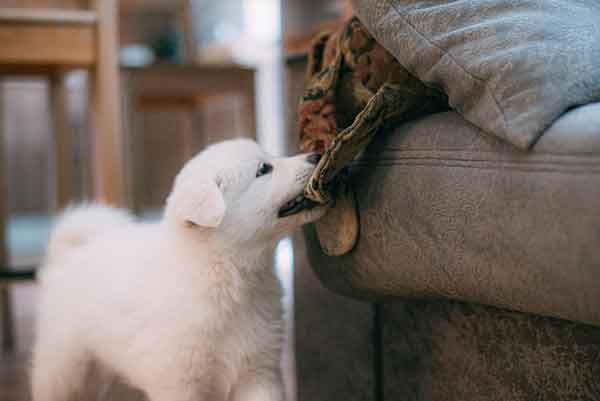Dog training is an art as much as it is a science. It requires understanding, patience, and a certain level of intuition.
One of the most critical aspects of dog training is teaching your canine companion not to bite. This issue is not only important for maintaining a harmonious relationship between you and your dog but also to ensure the safety of humans and other animals your dog may encounter.
Biting is often a result of fear, anxiety, or a lack of proper socialization. The process of teaching your dog not to bite is not about punishment, but rather about guiding them towards more appropriate ways of interacting with the world.
Whether you are a new dog owner or dealing with an older dog that still exhibits biting tendencies, this comprehensive guide aims to enhance your understanding of your dog’s behavior and assist you in fostering a peaceful and bite-free coexistence.
Understanding Why Dogs Bite
Biting is an innate instinct for dogs, which can be triggered by various factors. They may bite out of fear, to safeguard their territory, or when they feel uneasy.
Puppies often nip during teething or while acquainting themselves with their surroundings. Conversely, older dogs may bite as a result of pain or illness. Identifying the root cause behind biting serves as the initial step in modifying this behavior.
Gaining a deeper understanding of your dog’s perspective, you can tailor your approach to meet their specific needs and circumstances. If you are unsure of the cause, it is always best to consult a professional dog trainer or behaviorist for guidance.
In the case of an aggressive dog, seeking professional help is imperative for the safety of everyone involved. A lot of the time, biting can be prevented through early training and socialization, which brings us to our next topic.
The Importance of Training Your Dog Not to Bite
Biting can have severe consequences for both dogs and humans. Not only can it damage relationships between dogs and their owners, but it can also lead to legal repercussions in case of injuries caused by a dog bite.
Additionally, dogs who exhibit aggressive behaviors such as biting are often surrendered to shelters or euthanized, preventing them from living a happy and fulfilling life. By training your dog not to bite, you are not only ensuring the safety of those around them but also setting your canine companion up for success in their interactions with other animals and people.
For instance, a dog that is well-trained not to bite will be more welcome in public places, reducing the likelihood of conflict with other dogs or humans. It also allows for more freedom and socialization opportunities, resulting in a happier and healthier dog.
Furthermore, biting can cause serious injury or even death to smaller animals, such as cats or birds. Training your dog not to bite not only protects these vulnerable creatures but also promotes responsible pet ownership.

Legal Implications of A Dog Bite
As a dog owner, it is your responsibility to ensure that your canine companion does not pose a threat to others. If your dog bites someone, you may be held liable for any damages or injuries caused.
Depending on the severity of the bite and the laws in your area, you could face legal consequences such as fines, mandatory training classes, or even criminal charges. As indicated by the lawyers at https://www.eastonlawoffices.com/, it is crucial to understand the legal implications of a dog bite and take proactive measures to prevent it from happening.
For instance, dog owners should have proper insurance coverage in case of a dog bite incident. The emotional and physical trauma after a dog bite can be extensive, and it is essential to be prepared for such situations.
Those who are considering getting a dog should also research the laws and regulations in their area to ensure they are able to provide a safe environment for their pet.
Techniques for Teaching Your Dog Not to Bite
Teaching your dog not to bite requires employing various methods and techniques, each with its own advantages and challenges.
Consistency, patience, and compassion are key in your approach. It is important to avoid punishment or harsh methods as they can worsen the situation and harm your bond with your dog.
Instead, positive reinforcement is an effective and humane training approach. This involves rewarding your dog with treats, praise, or playtime for displaying desirable behaviors. By utilizing these strategies, you can successfully train your dog and foster a strong and loving relationship.
A popular technique for teaching bite inhibition, also known as soft mouthing, is to use toys instead of hands or feet when training puppies. During play, if a puppy nips at you, redirect their attention to a toy and offer praise when they choose to bite the toy instead. This helps them understand that biting on objects is acceptable, but not on human skin.
Additionally, teaching your dog the “leave it” command can also be highly beneficial in preventing unwanted biting behaviors.
Socializing Your Dog to Prevent Biting
Socialization is a fundamental component of preventing biting behaviors in dogs. By exposing your dog to different environments, people, and other animals, they learn to interact positively and reduce their likelihood of biting out of fear or anxiety.
It’s best to start socializing puppies at a young age, typically when they are between three and twelve weeks old. However, older dogs can also benefit from socialization. During the process, ensure your dog has positive experiences. Reward calm behavior and gently correct aggressive responses.
A good idea when you first introduce a new dog into your home is to keep them separated from other pets and gradually introduce them while supervised. This allows them to become familiar with each other’s scents and reduces the likelihood of conflict.
It’s also important to supervise interactions between dogs and children, as children may not understand how to safely interact with a dog. There are instances where even the most socialized dogs may still exhibit biting tendencies, and in such cases, it is crucial to seek professional help.

In the grand scheme of responsible pet ownership, it is imperative to train your dog to refrain from biting. This endeavor necessitates comprehension, patience, consistent training, and early socialization.
Although the process may appear daunting, the rewards of a well-behaved and sociable dog are immeasurable. The safety of your beloved pet and those in their vicinity relies on their training.
Remember, the objective is not to punish, but rather to guide your canine companion towards improved conduct. Should any challenges arise, do not hesitate to seek professional assistance.
As dog owners, it is our responsibility to ensure the well-being of our furry friends and those around them. So, let’s take the necessary steps to train our dogs not to bite and promote a harmonious and loving relationship with them.

